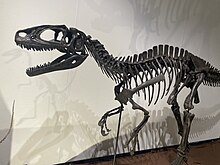Fukuiraptor
| Fukuiraptor Temporal range:Early Cretaceous,
| |
|---|---|

| |
| Reconstructed skeleton | |
| Scientific classification | |
| Domain: | Eukaryota |
| Kingdom: | Animalia |
| Phylum: | Chordata |
| Clade: | Dinosauria |
| Clade: | Saurischia |
| Clade: | Theropoda |
| Clade: | †Megaraptora |
| Genus: | †Fukuiraptor Azuma & Currie, 2000 |
| Type species | |
| †Fukuiraptor kitadaniensis Azuma & Currie, 2000
| |
Fukuiraptor( "thief ofFukui") was a medium-sizedmegaraptorantheropoddinosaur of theEarly Cretaceousepoch(eitherBarremianorAptian) that lived in what is nowJapan.[1]Fukuiraptoris known from theKitadani Formation[2]and possibly also theSebayashi Formation.[3]
History
[edit]
Thetype specimenis a partial skeleton (designatedFPDM-V97122) discovered in theKitadaniquarry nearKatsuyamain theFukui prefecture.It is thought that this specimen was not mature and an adult may have been larger. The remains of many other individuals have been found in the quarry, with numerous humeri, femurs, and teeth being assigned to this species.[2]However, the other individuals recovered from the same locality are mostly juveniles that were smaller than theholotype(Currie & Azuma, 2006), in the smallest case less than a quarter of the holotype's size. A tooth (NDC-P0001) discovered in a block ofconglomeratefrom theSebayashi Formationhas been referred toFukuiraptoras well.[4]
Description
[edit]
As indicated by its slender phalanges,Fukuiraptorwas a relatively lightly built animal, regardless of its maturity.[1]The immature holotype is estimated to reach 4.2 metres (14 ft) long and weigh 175 kg (386 lb) in its initial description.[1]In 2010Gregory Paulgave a length of 5 meters (16 ft) and a weight of 300 kg (660 lbs).[5]In 2014, its body mass was estimated up to 250 kilograms (550 lb).[6]Molina-Pérez and Larramendi estimated a length of 4.3 meters (14.1 ft) and a weight of 590 kg (1,300 lbs) in 2016.[7]
The distinctive teeth ofFukuiraptorshow similarities with bothcarcharodontosaurids(being very compressed and blade-like, as well as having wrinkled enamel) andtyrannosaurids(having oblique blood grooves near the serrations).[2]The holotype also had very large and flat manual unguals (hand claws), which played a role in its initial classification as a dromaeosaurid (as the hand claws were mistaken for foot claws) as well as its current classification as a megaraptoran.[8]
Classification
[edit]Initially considered a member of theDromaeosauridaewhen first discovered, its initial describers considered it acarnosaur,related toAllosaurus.More recent studies consider it a megaraptoran, an Enigma tic group which may have been part of the familyNeovenatoridae.[8]However, more recently, another analysis has proposed that allmegaraptoransare actuallytyrannosauroids,which would reclassifyFukuiraptoras atyrannosauroidcoelurosaur.[9]Recent cladistic analysis of the theropodGualichohas suggested thatFukuiraptorand other megaraptorans are eitherallosauroids,or non-tyrannosauroid basal coelurosaurs.[10]
It has been suggested thatFukuiraptoris a close relative to the Australian megaraptoran known asAustralovenator,[11]however a subsequent study has placedAustralovenatoras amegaraptoridmegaraptoran alongside other derived South American taxa, whileFukuiraptorremains a megaraptoran outside of Megaraptoridae.[12]
Below is a cladogram reconstructing the position ofFukuiraptorin the Megaraptora as per Delcourt and Grillo, 2018.[12]
| Megaraptora |
| ||||||
Palaeoecology
[edit]
In theKitadani Formation,where fossils ofFukuiraptorhave been recovered,[1]fossils of other vertebrates have been preserved. Among the species that have been properly described and named areFukuisaurus tetoriensis,[13]astyracosternornithischian,Fukuititan nipponensis,[14]atitanosauriformsauropod,Koshisaurus katsuyama,[15]ahadrosauroidornithischian,Fukuivenator paradoxus,[16]atherizinosauriantheropod,andFukuipteryx prima,[17]anavialanas defined by the authors.
External links
[edit]- Image of the holotype skeleton, published by the twitter account of Thomas Holtz
- "Fukuiraptor kitadaniensis".Fukui Prefectural Dinosaur Museum. Archived fromthe originalon 29 August 2006.
References
[edit]- ^abcdAzuma, Yoichi; Philip J., Currie (2000)."A new carnosaur (Dinosauria: Theropoda) from the Lower Cretaceous of Japan"(PDF).Canadian Journal of Earth Sciences.37(12): 1735–1753.Bibcode:2000CaJES..37.1735A.doi:10.1139/e00-064.
- ^abcCurrie, P.J.; Azuma, Y. (2006)."New specimens, including a growth series, ofFukuiraptor(Dinosauria, Theropoda) from the Lower Cretaceous Kitadani Quarry of Japan ".J. Paleont. Soc. Korea.22(1): 173–193 – via ResearchGate.
- ^"A tooth of Fukuiraptor aff. F. kitadaniensis from the Lower Cretaceous Sebayashi Formation, Sanchu Cretaceous, Japan: Đông Kinh học vân đại học リポジトリ".ir.u-gakugei.ac.jp.Retrieved9 October2020.
- ^Molnar, Ralph E.; Obata, Ikuwo; Tanimoto, Masahiro; Matsukawa, Masaki (2009)."A tooth of Fukuiraptor aff. F. kitadaniensis from the Lower Cretaceous Sebayashi Formation, Sanchu Cretaceous, Japan".Bulletin of Tokyo Gakugei University, Division of Natural Sciences.61:105–117 – via ResearchGate.
- ^Paul, Gregory S. (2010).The Princeton Field Guide to Dinosaurs.New Jersey: Princeton University Press. p. 98.
- ^Benson, Roger B. J.; Campione, Nicolás E.; Carrano, Matthew T.; Mannion, Philip D.; Sullivan, Corwin; Upchurch, Paul; Evans, David C. (6 May 2014)."Rates of Dinosaur Body Mass Evolution Indicate 170 Million Years of Sustained Ecological Innovation on the Avian Stem Lineage".PLOS Biology.12(5): e1001853.doi:10.1371/journal.pbio.1001853.ISSN1545-7885.PMC4011683.PMID24802911.Supporting Information
- ^Molina-Pérez & Larramendi (2016).Récords y curiosidades de los dinosaurios Terópodos y otros dinosauromorfos.Barcelona, Spain: Larousse. p. 263.
- ^abBenson, R. B. J.; Carrano, M. T.; Brusatte, S. L. (2010)."A new clade of archaic large-bodied predatory dinosaurs (Theropoda: Allosauroidea) that survived to the latest Mesozoic".Naturwissenschaften.97(1): 71–78.Bibcode:2010NW.....97...71B.doi:10.1007/s00114-009-0614-x.PMID19826771.S2CID22646156.
- ^Novas, F. E.; Agnolín, F. L.; Ezcurra, M. D.; Canale, J. I.; Porfiri, J. D. (2012)."Megaraptorans as members of an unexpected evolutionary radiation of tyrant-reptiles in Gondwana".Ameghiniana.49(4(R): Suplemento Resúmenes [Abstracts]): R33.
- ^Apesteguía, Sebastián; Smith, Nathan D.; Valieri, Rubén Juárez; Makovicky, Peter J. (13 July 2016)."An Unusual New Theropod with a Didactyl Manus from the Upper Cretaceous of Patagonia, Argentina".PLOS ONE.11(7): e0157793.Bibcode:2016PLoSO..1157793A.doi:10.1371/journal.pone.0157793.ISSN1932-6203.PMC4943716.PMID27410683.
- ^Currie, Phillip J.; Coria, Rodolfo A. (20 July 2016)."A New Megaraptoran Dinosaur (Dinosauria, Theropoda, Megaraptoridae) from the Late Cretaceous of Patagonia".PLOS ONE.11(7): e0157973.Bibcode:2016PLoSO..1157973C.doi:10.1371/journal.pone.0157973.PMC4954680.PMID27439002.
- ^abDelcourt, Rafael; Grillo, Orlando Nelson (15 December 2018)."Tyrannosauroids from the Southern Hemisphere: Implications for biogeography, evolution, and taxonomy".Palaeogeography, Palaeoclimatology, Palaeoecology.511:379–387.Bibcode:2018PPP...511..379D.doi:10.1016/j.palaeo.2018.09.003.ISSN0031-0182.S2CID133830150.
- ^Kobayashi, Yoshitsugu; Azuma, Yoichi (11 April 2003)."A new iguanodontian (Dinosauria: Ornithopoda) from the Lower Cretaceous Kitadani Formation of Fukui Prefecture, Japan".Journal of Vertebrate Paleontology.23(1): 166–175.doi:10.1671/0272-4634(2003)23[166:anidof]2.0.co;2.ISSN0272-4634.S2CID131386181.
- ^Azuma, Yoichi; Shibata, Masateru (2010)."Fukuititan nipponensis, A New Titanosauriform Sauropod from the Early Cretaceous Tetori Group of Fukui Prefecture, Japan".Acta Geologica Sinica - English Edition.84(3): 454–462.Bibcode:2010AcGlS..84..454A.doi:10.1111/j.1755-6724.2010.00268.x.ISSN1755-6724.S2CID128897110.
- ^"New basal hadrosauroid (Dinosauria: Ornithopoda) from the Lower Cretaceous Kitadani Formation, Fukui, central Japan"(PDF).Zootaxa.
- ^Azuma, Yoichi; Xu, Xing; Shibata, Masateru; Kawabe, Soichiro; Miyata, Kazunori; Imai, Takuya (23 February 2016)."A bizarre theropod from the Early Cretaceous of Japan highlighting mosaic evolution among coelurosaurians".Scientific Reports.6(1): 20478.Bibcode:2016NatSR...620478A.doi:10.1038/srep20478.ISSN2045-2322.PMC4763874.PMID26908367.
- ^Imai, Takuya; Azuma, Yoichi; Kawabe, Soichiro; Shibata, Masateru; Miyata, Kazunori; Wang, Min; Zhou, Zhonghe (14 November 2019)."An unusual bird (Theropoda, Avialae) from the Early Cretaceous of Japan suggests complex evolutionary history of basal birds".Communications Biology.2(1): 399.doi:10.1038/s42003-019-0639-4.ISSN2399-3642.PMC6856171.PMID31754639.















